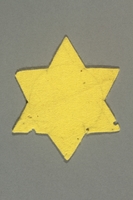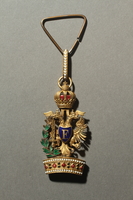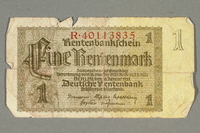Overview
- Description
- The Adler family papers document the Holocaust experiences of brothers Denis and János Adler, originally of Szeged, Hungary, and members of their extended families. The collection contains correspondence, biographical materials, immigration documents, restitution claims, and photographs regarding pre-war family lives; Denis’s emigration from Szeged in 1939; János’s conscription into the Hungarian Labor Service that accompanied German troops during the invasion of the Soviet Union, and his subsequent wounding and imprisonment in the field hospital in Alexajewka-Nikolajewka; the imprisonment and forced labor of Eva Adler, her mother Berta Neumann, and Borsca Adler in the Strasshof labor camp, Bergen-Belsen concentration camp, and Theresienstadt concentration camp; and post-war immigration to the United States.
The biographical materials primarily contain birth, marriage, and death certificates; identification documents such as passports; employment records; and school records and diplomas. Other materials include documents related to Denis Adler’s medical profession in Szeged, Paris, and Los Angeles; János Adler’s brief name change to János Arató in 1946; accounting sheets of Eva Adler that likely represent clothing she made and sold; and records for the sale of a family property in Szeged in 1947. In addition, there are documents regarding Eva Adler, Borsca Adler, and Berta Neumann’s imprisonment in Theresienstadt concentration camp, and their repatriation from there to Szeged in late 1945.
The bulk of the correspondence consists of letters exchanged among family members from 1938-1945. Many of the letters were received by Denis Adler, Lisa Timár, and Gyula Neumann, all of whom had arrived in the United States by 1941. The correspondence of Denis Adler also includes letters received by his brother János discussing family news and the conditions in Szeged in the fall of 1945; and letters by Raymonde Grumbach and Francois Moutier, both of whom were doctors Denis worked with while in Paris. The correspondence of Lisa Timár includes letters from János and Eva in Szeged to Lisa, 1937-1941; and extensive letters from her stepfather Gyula Neumann. Other correspondence includes postcards exchanged between János and Eva after János was conscripted into the Hungarian Labor Service and sent to Kunszentmiklós. There is also post-war correspondence of János from his former school friends and his teacher Jozsef Kerkai.
The emigration and immigration papers primarily document János, Eva, and Borsca Adler’s efforts to immigrate to the United States after the war. Included are application materials, travel documents, and correspondence. There is also correspondence between Denis Adler and the United States Department of State on behalf of his mother, Borsca.
The restitution claims contain records relating to the Adler family’s restitution claims through the Foreign Claims Settlement Commission of the United States, and the Austrian Reconciliation Fund. Included are applications, supporting documents, and correspondence.
The photographs primarily document the Adler and Timár families’ pre-war lives in Szeged, but also include some wartime photographs and post-war depictions of family life in Szeged and the United States. The pre-war photographs include childhood photographs of Eva, Lisa, Denis, and János; various related family members; Jewish social events attended by Eva and Lisa; and Denis’s medical school. Wartime photographs include Denis with other doctors in Paris, aboard the S.S. Winnipeg, and in custody in Trinidad in 1941 while en-route to the United States; Janós with Jewish labor troops, likely in Kiszomber and Makó; and probably French prisoners in Szeged and Haag, Austria. Post-war photographs include Janós and Eva’s apartment in Szeged and various family members in the United States.
The ephemera include a cookbook from Bergen-Belsen that was owned by Eva Adler, a prayer book in Hungarian, and a collection of writings that were likely authored by Lisa Timár. - Date
-
inclusive:
circa 1880 September-2003
- Credit Line
- United States Holocaust Memorial Museum Collection, Gift of Barbara Adler
- Collection Creator
- Adler family
- Biography
-
Rezsö Adler (1874-1939) and Borsca Cziklai (sometimes referred to as Borbala or Boriska; later Barbara; 1885-1975), both of Szeged, Hungary, married in 1904. Borsca was the daughter János and Rosa Cziklai. She had four siblings, Ilona (1876-1980), Margit (1878-1945) Màtyàs (1889-1946), and Rozsa (1891-1977). Borsca and Rezsö had two sons, Denis (born Dénes, nicknamed Dini; 1914-2011) and János (nicknamed Jancsi, briefly changed his last name to Arato, later John; 1905-1994), as well as two other children who died young, Béla and Magda. Rezsö worked in the grain industry. He also served in the Hungarian army during World War I, and was wounded in 1916. He died in 1939 from angina.
Denis studied medicine, graduating with a Ph.D. in 1938. He worked in Makó, and Budapest, Hungary after graduation. After his father’s death in April 1939, and with the increasing difficulty of Jews to practice medicine in Hungary, he began to look for ways to emigrate. He found a position in Paris, France with Dr. Francois Moutier, and moved there in May 1939. Through assistance with his family, he was able to secure an American visa despite the difficulties of living in German-occupied Paris after 1940. He left Paris in April 1941 with the assistance of a guide who led him out of the city, and took a train to Marseille. From there, he boarded the S.S. Winnipeg to sail to New York via Martinique. The ship was diverted to Port of Spain, Trinidad, where the passengers were taken off the boat. Denis was detained by the British Navy and accused of being a spy due to his fluency with German. He was released after two weeks and sailed to the United States on the S.S. Arcadia. He continued to practice medicine as a radiologist, first in Cincinnati, Ohio in 1943, and then in New York, 1944-1945. He married Patricia Valentine (1921-) in 1943, and they moved to Los Angeles, California in 1945. He continued to practice as a radiologist, and also taught radiology and the University of Southern California. They had three children, Steven (1947-), Thomas (1949-), and Barbara (1951-). Denis and Patricia divorced in 1965, and he married Sylvia Betron (1918-2000) in 1969.
János attended the Vienna University of Economics and Business in Austria (then known as Hochschule für Welthandel), graduating in 1927. He then moved back to Szeged and began working for the Agraria Merchandising Corporation, a grain business founded by his father. He married Eva Timár in 1937. In 1942, János was conscripted into the Hungarian Labor Service, and sent to a military camp in Kunszentmiklos, and was assigned to Battalion 254. In October 1942, he stepped on a Russian landmine and sustained serious injuries to his leg. He was sent to the field hospital in Alexajewka-Nikolajewka. In January 1943, the Germans and Hungarians fled the hospital due to the advancing Red Army. The Russians took control of the hospital, and János was sent to a prison camp (sometimes referred to as Prison Camp 188) in Tambov, Russia. The Russians assigned him to deliver political lectures to German prisoners-of-war on topics related to the Soviet Union. He remained at the camp until the end of the war. Upon returning to Szeged, he learned that Eva, her mother Berta Neumann, and his mother Borsca all survived the war and had returned to the city. János and Eva immigrated to the United States in 1948, first travelling out of Hungary to London, and then taking the S.S. Queen Elizabeth to New York. They settled in Los Angeles where János worked for the Capital Brush Company, eventually becoming vice-president.
Berta Neumann (née Hoffer; 1886-1980) was born in Szeged to Marcus Hoffer (1859-1934) and Maria Gelberger (1870-1942). She had four siblings, Rhoda (later Rhoda Lakond; 1899-1983), Adrianne (1913-), Stephanis, and Léopold (d. 1976). She was married to Dezsö Timár (1882-) and they had two daughters, Lisa (later Lisa Foldes; 1912-1986) and Eva (later Eva Adler; 1913-2007). She and Dezsö divorced, and she later married Gyula Neumann (later Julius; 1879-1945), a wealthy wine and liquor merchant. They had one daughter, Zsuzsa (later Susan Foldes). Gyula traveled to New York in 1939 for the World’s Fair, during which World War II began. He remained in New York and Cincinnati for the duration of the war, dying of a heart attack in 1945.
Zsuzsa survived the war in Budapest by hiding. She was married to Paul Foldes (1914-2001), who was sent to a camp but also survived. They planned to immigrate to the United States after the war, but only Zsuzsa was able to get a visa. She moved to Cincinnati where her sister Lisa lived, but died after getting hit by a truck. Paul, who was in Cuba at the time of her death trying to secure a visa, was granted permission to come to her funeral. While in the United States, he married her sister Lisa in order to remain in the country.
Lisa Timár was a trained pianist who studied at the Royal Hungarian Franz Liszt Conservatory of Music. She also studied dietetics at the University of Szeged. In 1937 she immigrated to New York, and later settled in Cincinnati. She worked as a food service manager for the Shillito’s department store.
Eva attended St. Ursula Convent School in Glasenbach, Austria. After graduation from the finishing school, and a brief time working at the opera house in Budapest, Eva apprenticed with a furrier workshop in Szeged. She then worked at a knitting factory from 1936-1940. She married János Adler in 1937.
In March 1944, the Germans occupied Hungary, and the Jews in Szeged were sent to the ghetto. In June 1944, Borsca, her sister Margit, Eva, and her mother Berta were sent to the Strasshof labor camp in Vienna, Austria where they performed forced-labor in a brick factory. In October 1944, they were sent to the Bergen-Belsen concentration camp, and in May 1945 they were transported to Theresienstadt, which was soon liberated by the Russians. Borsca and her sister Margit both contracted typhus. Margit perished but Borsca survived. After the war, Borsca, Eva, and Berta all went back Szeged. Borsca and Berta immigrated to the United States in 1946. Borsca settled in Los Angles, and Berta settled first in Cincinnati, and later in Los Angeles.
Physical Details
- Genre/Form
- Photographs. Photograph albums. Correspondence.
- Extent
-
4 boxes
8 book enclosures
3 oversize folders
1 oversize box
- System of Arrangement
- The collection is arranged as six series: Series 1: Biographical material, 1892-1986; Series 2: Correspondence, 1937-circa 2002; Series 3: Emigration and Immigration, 1944-1954; Series 4: Restitution claims, 1938-2003; Series 5: Photographs, circa 1880s-2003; Series 6: Ephemera, 1914-1995.
Each series is arranged alphabetically by folder title. Documents are arranged chronologically. The family names used were determined by what appeared most frequently in the documents.
Rights & Restrictions
- Conditions on Access
- There are no known restrictions on access to this material.
- Conditions on Use
- Material(s) in this collection may be protected by copyright and/or related rights. You do not require further permission from the Museum to use this material. The user is solely responsible for making a determination as to if and how the material may be used.
Keywords & Subjects
- Topical Term
- Jewish families--Hungary. Holocaust Jewish (1939-1945)--Hungary--History. Jewish ghettos--Hungary--Szeged. Jewish physicians--Hungary. Restitution and indemnification claims (1933-) Emigration and immigration--United States. Concentration camps. Forced labor--Austria--Vienna. Forced labor--Hungary. Prisoner-of-war camps--Soviet Union. Soviet Union. Red Army. Passenger ships
- Geographic Name
- Szeged (Hungary) Paris (France) Cincinnati (Ohio) Los Angeles (Calif.)
Administrative Notes
- Holder of Originals
-
United States Holocaust Memorial Museum
- Legal Status
- Permanent Collection
- Provenance
- The Adler family papers were donated to the United States Holocaust Memorial Museum by Barbara Adler in 2016.
- Record last modified:
- 2023-06-08 07:45:28
- This page:
- https://collections.ushmm.org/search/catalog/irn537260
Additional Resources
Download & Licensing
In-Person Research
- Available for Research
- Plan a Research Visit
-
Request in Shapell Center Reading Room
Bowie, MD
Contact Us
Also in Denes and Janos Adler family collection
The collection consists of a World War I medal, scrip and currency, a Star of David badge, a tablecloth, albums, correspondence, documents, photographs, and a publication related to the experience of brothers Denes and Janos Adler, originally of Szeged, Hungary, and members of their extended families, as well as the family of Eva Timar Adler before, during, and after the Holocaust, when Denes emigrated before the war and Eva and Janos survived forced labor camps and emigrated to the United States following the war.
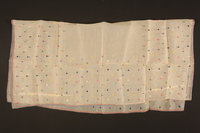
Embroidered tablecloth made in a forced labor camp
Object
Embroidered tablecloth made by Eva Timas in a forced labor camp in Hagg, Austria.
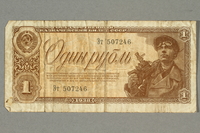
Soviet Union, one ruble note
Object
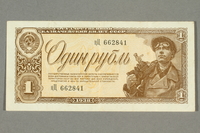
Soviet Union, one ruble note
Object
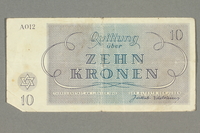
Theresienstadt ghetto-labor camp scrip, 10 kronen note
Object
Scrip, valued at 10 (zehn) kronen, of the type distributed in Theresienstadt (Terezin) ghetto-labor camp beginning in May 1943. The ghetto currency was printed by the National Bank in 7 denominations: 1, 2, 5, 10, 20, 50, 100. Inmates were not allowed to have currency, which was confiscated. The SS ordered the Jewish Council to design scrip for use only in the camp. It was issued to create a false appearance of normalcy. There was little to obtain with the scrip. Located thirty miles northwest of Prague in German occupied Czechoslovakia, the camp was established by the Germans in November 24, 1941, and ceased operation in early May 1945. In 3.5 years, approximately 140,000 Jewish persons were transferred to Terezin; nearly 90,000 were then deported, likely to their death, further east. About 33,000 died in Theresienstadt.
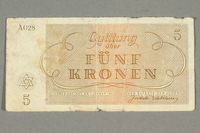
Theresienstadt ghetto-labor camp scrip, 5 kronen note
Object
Scrip, valued at 5 [funf] kronen, of the type distributed in Theresienstadt (Terezin) ghetto-labor camp beginning in May 1943. The ghetto currency was printed by the National Bank in 7 denominations: 1, 2, 5, 10, 20, 50, 100. Inmates were not allowed to have currency, which was confiscated. The SS ordered the Jewish Council to design scrip for use only in the camp, which was issued to create a false appearance of normalcy. There was little to obtain with the scrip. Located thirty miles northwest of Prague in German occupied Czechoslovakia, the camp was established by the Germans in November 24, 1941, and ceased operation in early May 1945. In 3.5 years, approximately 140,000 Jewish persons were transferred to Terezin; nearly 90,000 were then deported, likely to their death, further east. About 33,000 died in Theresienstadt.
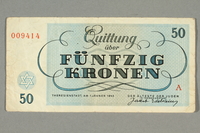
Theresienstadt ghetto-labor camp scrip, 50 kronen note
Object
Scrip, valued at 50 (funfzig) kronen, of the type distributed in Theresienstadt (Terezin) ghetto-labor camp beginning in May 1943. The ghetto currency was printed by the National Bank in 7 denominations: 1, 2, 5, 10, 20, 50, 100. Inmates were not allowed to have currency, which was confiscated. The SS ordered the Jewish Council to design scrip for use only in the camp, where it was issued to create a false appearance of normalcy. There was little to obtain with the scrip. Located thirty miles northwest of Prague in German occupied Czechoslovakia, the camp was established by the Germans in November 24, 1941, and ceased operation in early May 1945. In 3.5 years, approximately 140,000 Jewish persons were transferred to Terezin; nearly 90,000 were then deported, likely to their death, further east. About 33,000 died in Theresienstadt.
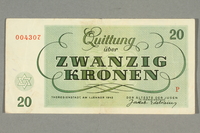
Theresienstadt ghetto-labor camp scrip, 20 kronen note
Object
Scrip, valued at 20 (zwanzig) kronen, of the type distributed in Theresienstadt (Terezin) ghetto-labor camp beginning in May 1943. The ghetto currency was printed by the National Bank in 7 denominations: 1, 2, 5, 10, 20, 50, 100. Inmates were not allowed to have currency, which was confiscated. The SS ordered the Jewish Council to design scrip for use only in the camp. It was issued to create a false appearance of normalcy. There was little to obtain with the scrip. Located thirty miles northwest of Prague in German occupied Czechoslovakia, the camp was established by the Germans in November 24, 1941, and ceased operation in early May 1945. In 3.5 years, approximately 140,000 Jewish persons were transferred to Terezin; nearly 90,000 were then deported, likely to their death, further east. About 33,000 died in Theresienstadt.
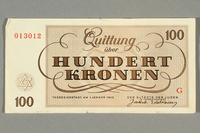
Theresienstadt ghetto-labor camp scrip, 100 kronen note
Object
Scrip, valued at 100 (ein hundert) kronen, of the type distributed in Theresienstadt (Terezin) ghetto-labor camp beginning in May 1943. The ghetto currency was printed by the National Bank in 7 denominations: 1, 2, 5, 10, 20, 50, 100. Inmates were not allowed to have currency, which was confiscated. The SS ordered the Jewish Council to design scrip for use only in the camp, where it was issued to create a false appearance of normalcy. There was little to obtain with the scrip. Located thirty miles northwest of Prague in German occupied Czechoslovakia, the camp was established by the Germans in November 24, 1941, and ceased operation in early May 1945. In 3.5 years, approximately 140,000 Jewish persons were transferred to Terezin; nearly 90,000 were then deported, likely to their death, further east. About 33,000 died in Theresienstadt.
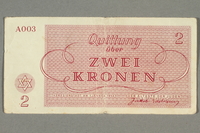
Theresienstadt ghetto-labor camp scrip, 2 kronen note
Object
Scrip, valued at 2 (zwei) kronen, of the type distributed in Theresienstadt (Terezin) ghetto-labor camp beginning in May 1943. The ghetto currency was printed by the National Bank in 7 denominations: 1, 2, 5, 10, 20, 50, 100. Inmates were not allowed to have currency, which was confiscated. The SS ordered the Jewish Council to design scrip for use only in the camp. It was issued to create a false appearance of normalcy. There was little to obtain with the scrip. Located thirty miles northwest of Prague in German occupied Czechoslovakia, the camp was established by the Germans in November 24, 1941, and ceased operation in early May 1945. In 3.5 years, approximately 140,000 Jewish persons were transferred to Terezin; nearly 90,000 were then deported, likely to their death, further east. About 33,000 died in Theresienstadt.
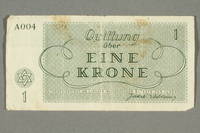
Theresienstadt ghetto-labor camp scrip, 1 krone note
Object
Scrip, valued at 1 (eine) krone, of the type distributed in Theresienstadt (Terezin) ghetto-labor camp beginning in May 1943. The ghetto currency was printed by the National Bank in 7 denominations: 1, 2, 5, 10, 20, 50, 100. Inmates were not allowed to have currency, which was confiscated. The SS ordered the Jewish Council to design scrip for use only in the camp. It was issued to create a false appearance of normalcy. There was little to obtain with the scrip. Located thirty miles northwest of Prague in German occupied Czechoslovakia, the camp was established by the Germans in November 24, 1941, and ceased operation in early May 1945. In 3.5 years, approximately 140,000 Jewish persons were transferred to Terezin; nearly 90,000 were then deported, likely to their death, further east. About 33,000 died in Theresienstadt.
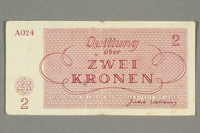
Theresienstadt ghetto-labor camp scrip, 2 kronen note
Object
Scrip, valued at 2 (zwei) kronen, of the type distributed in Theresienstadt (Terezin) ghetto-labor camp beginning in May 1943. The ghetto currency was printed by the National Bank in 7 denominations: 1, 2, 5, 10, 20, 50, 100. Inmates were not allowed to have currency, which was confiscated. The SS ordered the Jewish Council to design scrip for use only in the camp. It was issued to create a false appearance of normalcy. There was little to obtain with the scrip. Located thirty miles northwest of Prague in German occupied Czechoslovakia, the camp was established by the Germans in November 24, 1941, and ceased operation in early May 1945. In 3.5 years, approximately 140,000 Jewish persons were transferred to Terezin; nearly 90,000 were then deported, likely to their death, further east. About 33,000 died in Theresienstadt.

